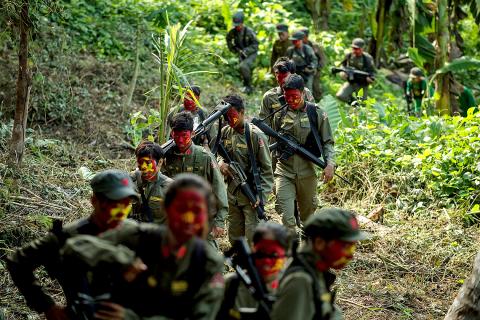A kerosene lamp flickers beside a Macbook in a jungle camp as aging Philippine communist leader Jaime Padilla plots the next step in one of Asia’s oldest insurgencies with a new generation of fighters.
Fueled by one of the world’s starkest rich-poor divides, a Maoist rebellion that began months before the first human landed on the moon plods on even though the country now boasts one of the world’s fastest-growing economies.
“There’s a big pool of young people who will pursue the people’s war even if it takes us a hundred or more years,” 70-year-old Padilla, one of the Philippines’ most-wanted men, said at a rare news conference for a small group of reporters.

Photo: Noel Celis, AFP
Padilla, who joined the New People’s Army (NPA) a few years after the insurgency began in the late 1960s, insisted the rebels were not concerned by President Rodrigo Duterte’s threats to end peace talks.
A self-proclaimed socialist, Duterte swiftly launched negotiations with the Maoists after winning presidential elections last year and there were high hopes he could end the rebellion, which the military estimates has claimed 30,000 lives.
But last month Duterte angrily declared there would be no more talks because the NPA continued to extort money from businesses and ambush security forces.

hoto: Noel Celis, AFP
Padilla, a slight, bespectacled ex-farmer who goes by the alias “Ka (Comrade) Diego”, heads the Melito Glor Command, one of the most important units of the NPA, the communists’ 3,800-member armed wing, military commanders said.
The unit operates across the south of the main island of Luzon, the country’s industrial heartland that lies next to the capital of Manila, typically attacking isolated security outposts and taking guns from slain police and soldiers.
It also collects “revolutionary taxes” from businesses, ranging from big power plants and even small pig farms, as well as local politicians, Padilla said.
JUNGLE DWELLINGS
The guerrillas sleep in hammocks near streams and rural hamlets, help farmers harvest crops, and melt into nearby forests to evade any approaching large military forces.
They choose only to fight smaller units, according to Padilla.
His press conference was held on a hilltop ringed with wild banana plants, about two hours’ hike from a poor, coconut-growing hamlet.
The 50 or so gunmen escorting him wore olive military-style uniforms inspired by Chinese revolutionary leader Mao Zedong (毛澤東), the movement’s ideological godfather.
Most also had on thick red makeup, many decorated with the hammer-and-sickle communist logo rendered in yellow, to conceal their identities.
While their numbers are relatively small, there continue to be frequent reports of communists killing security forces across the Philippines. Last month the rebels killed six policemen and a civilian in an ambush on the central island of Negros, according to the police, and wounded five of Duterte’s military bodyguards in another encounter in the southern Philippines.
Padilla said the rebels wanted the talks, held in Europe, to continue. But they stood ready to fight.
“We’ve been fighting for 50 years. What does it matter if it takes another 50 years,” said Padilla, who gave a slide presentation by lamplight with the help of a young female guerrilla.
Padilla defended the continuing NPA attacks, calling them a form of “self-defence” against military operations in areas where their shadow government was in place.
‘REVOLUTIONARY TAX’
He also insisted it was legitimate to demand the equivalent of two percent of any business project in revolutionary taxes, but admitted companies that refused to pay were punished “harshly,” with their equipment usually burnt.
The payments are vital to the communists’ survival.
They net the rebels up to two billion pesos each year, Philippine military spokesman Brigadier-General Restituto Padilla, no relation to the rebel leader, stated, branding the practice plain “extortion.” “This paralyzes the local economies, keeps people poor and makes it easier to recruit them. It’s a vicious cycle,” the general said.
Another key reason that the Philippines continues to host a communist rebellion when Marxism has dissolved almost everywhere else around the world is an economic system that has created huge wealth but left tens of millions in deep poverty.
The Philippines has one of the fastest growing economies in Asia and has grown by more than six percent for much of the past decade.
But 22 million, or one in five Filipinos, continue to earn a dollar or less each day, according to government data.
Padilla, the NPA leader, said millions more young Filipino adults fared little better working in low-paying contractual jobs after completing their schooling.
This made the NPA a viable option even for fresh graduates of the country’s top universities, he added.
One of them, a 25-year-old from a middle-class family who called herself Ka Kathryn, said she joined the NPA five years ago after her father, an engineer, was fired for organizing a union at an energy company.
“We are facing an enemy who has committed atrocities against the people,” said Kathryn, who had studied to become a television presenter but now carries an M-16 rifle.
“We should stand up to them and not cower in fear.”

May 11 to May 18 The original Taichung Railway Station was long thought to have been completely razed. Opening on May 15, 1905, the one-story wooden structure soon outgrew its purpose and was replaced in 1917 by a grandiose, Western-style station. During construction on the third-generation station in 2017, workers discovered the service pit for the original station’s locomotive depot. A year later, a small wooden building on site was determined by historians to be the first stationmaster’s office, built around 1908. With these findings, the Taichung Railway Station Cultural Park now boasts that it has

The latest Formosa poll released at the end of last month shows confidence in President William Lai (賴清德) plunged 8.1 percent, while satisfaction with the Lai administration fared worse with a drop of 8.5 percent. Those lacking confidence in Lai jumped by 6 percent and dissatisfaction in his administration spiked up 6.7 percent. Confidence in Lai is still strong at 48.6 percent, compared to 43 percent lacking confidence — but this is his worst result overall since he took office. For the first time, dissatisfaction with his administration surpassed satisfaction, 47.3 to 47.1 percent. Though statistically a tie, for most

Wooden houses wedged between concrete, crumbling brick facades with roofs gaping to the sky, and tiled art deco buildings down narrow alleyways: Taichung Central District’s (中區) aging architecture reveals both the allure and reality of the old downtown. From Indigenous settlement to capital under Qing Dynasty rule through to Japanese colonization, Taichung’s Central District holds a long and layered history. The bygone beauty of its streets once earned it the nickname “Little Kyoto.” Since the late eighties, however, the shifting of economic and government centers westward signaled a gradual decline in the area’s evolving fortunes. With the regeneration of the once

In February of this year the Taipei Times reported on the visit of Lienchiang County Commissioner Wang Chung-ming (王忠銘) of the Chinese Nationalist Party (KMT) and a delegation to a lantern festival in Fuzhou’s Mawei District in Fujian Province. “Today, Mawei and Matsu jointly marked the lantern festival,” Wang was quoted as saying, adding that both sides “being of one people,” is a cause for joy. Wang was passing around a common claim of officials of the People’s Republic of China (PRC) and the PRC’s allies and supporters in Taiwan — KMT and the Taiwan People’s Party — and elsewhere: Taiwan and